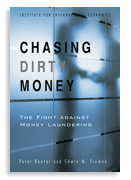Chasing Dirty Money
The Fight Against Money Laundering
November 2004
 Originally developed to reduce drug trafficking, national and international efforts to reduce money laundering have broadened over the years to address other crimes, and most recently, terrorism. These efforts now constitute a formidable regime applied to financial institutions and transactions throughout much of the world. Yet few assessments of either the achievements or consequences of this regime have been made.
Originally developed to reduce drug trafficking, national and international efforts to reduce money laundering have broadened over the years to address other crimes, and most recently, terrorism. These efforts now constitute a formidable regime applied to financial institutions and transactions throughout much of the world. Yet few assessments of either the achievements or consequences of this regime have been made.
Reuter and Truman (1) explore what is know about the scale and characteristics of money laundering, (2) describe the current anti-money laundering regime, (3) develop a framework for assessing the effectiveness of the regime, and (4) use that framework to assess how well the current system works and make proposals for its improvement.
PrefaceAcknowledgments
1. Chasing Dirty Money [pdf]
2. How Much Money is Laundered? [pdf]
3. Money Laundering: Methods and Markets [pdf]
4. The Anti-Money Laundering Regime [pdf]
5. Combating Predicate Crimes Involved in Money Laundering [pdf]
6. Protecting Financial System Integrity [pdf]
7. Combating Global "Public Bads" [pdf]
8. Improving the Global AML Regime [pdf]
References
Glossary
Index






